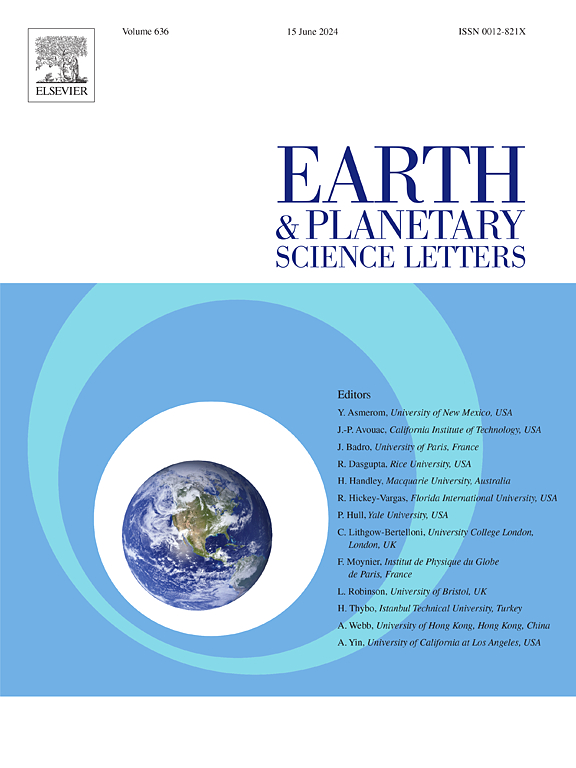水在降低大气压力下结冰的复杂性
IF 4.8
1区 地球科学
Q1 GEOCHEMISTRY & GEOPHYSICS
引用次数: 0
摘要
太阳系中许多冰状天体的表面都因冰火山活动而重新出现,在冰火山活动期间,液体和蒸汽从地下释放到寒冷、接近真空的环境中。水是最常见的释放液体之一,但它在低压下不稳定——在水面附近沸腾会导致快速冷却并诱发表面冻结。尽管以前的理论工作和实验室实验,仍然不清楚这三个共存的相是如何相互作用的。在这里,我们将大量液态水(17升和5升)暴露在低压下,以研究相变如何在近表层相互作用,以及是什么控制了系统的动力学。我们观察到,地下沸腾和相关气泡的形成显著地影响了冻结的速度和方式。上升的蒸汽使冰变形并使其破裂,从而释放出地下压力。一旦压力释放,下面的液态水再次暴露在降低的大气压力下,引发一个新的循环:剧烈沸腾,气泡形成,冰变形,随后破裂。因此,沸腾和冻结的时间被延长了。此外,我们观察到,冰层下的破裂和蒸汽积聚造成了一个不均匀的表面,其特征是几厘米高的凸起和凹陷。这表明,在喷涌的冰火火山爆发期间,冰的凝固可能是一个高度复杂的过程,可能在冰火火山的池塘和流动中留下明显的、可观察到的特征。本文章由计算机程序翻译,如有差异,请以英文原文为准。
The complexity of water freezing under reduced atmospheric pressure
The surfaces of many icy bodies in the Solar System have been resurfaced by cryovolcanism, during which liquid and vapour are released from the subsurface into cold, near-vacuum conditions. Water is one of the most commonly released liquids, but it is not stable at low pressure – boiling near the water surface causes rapid cooling and induces surface freezing. Despite previous theoretical works and laboratory experiments it remains unclear how the three coexisting phases interact. Here we expose large volumes of liquid water (17 and 5 litres) to low pressure to study how the phase transitions interact in the near-surface layer, and what controls the dynamics of the system. We observe that subsurface boiling and associated bubble formation significantly affects the rate and manner of freezing. Ascending vapour deforms the ice and causes it to crack, which releases subsurface pressure. Once the pressure is released, the underlying liquid water is again exposed to the reduced atmospheric pressure, triggering a new cycle of vigorous boiling, bubble formation, ice deformation, and subsequent cracking. Thereby, the period of boiling and freeze-over is prolonged. Additionally, we observe that fracturing and vapour accumulation beneath the ice layer create an uneven surface, characterized by bumps and depressions a few centimetres in height. This shows that ice solidification during effusive cryovolcanic eruptions is likely to be a highly complex process and could leave distinct, observable signatures on and within cryolava ponds and flows.
求助全文
通过发布文献求助,成功后即可免费获取论文全文。
去求助
来源期刊

Earth and Planetary Science Letters
地学-地球化学与地球物理
CiteScore
10.30
自引率
5.70%
发文量
475
审稿时长
2.8 months
期刊介绍:
Earth and Planetary Science Letters (EPSL) is a leading journal for researchers across the entire Earth and planetary sciences community. It publishes concise, exciting, high-impact articles ("Letters") of broad interest. Its focus is on physical and chemical processes, the evolution and general properties of the Earth and planets - from their deep interiors to their atmospheres. EPSL also includes a Frontiers section, featuring invited high-profile synthesis articles by leading experts on timely topics to bring cutting-edge research to the wider community.
 求助内容:
求助内容: 应助结果提醒方式:
应助结果提醒方式:


